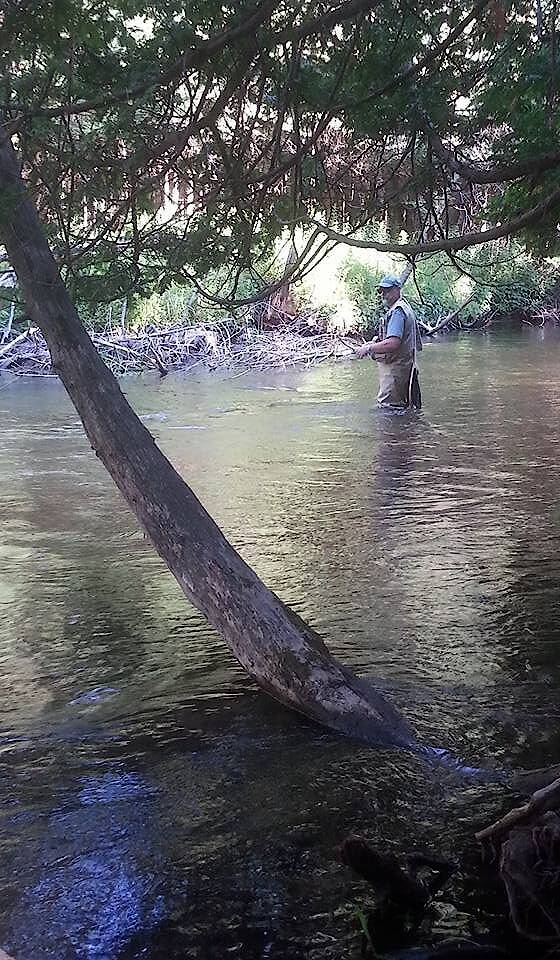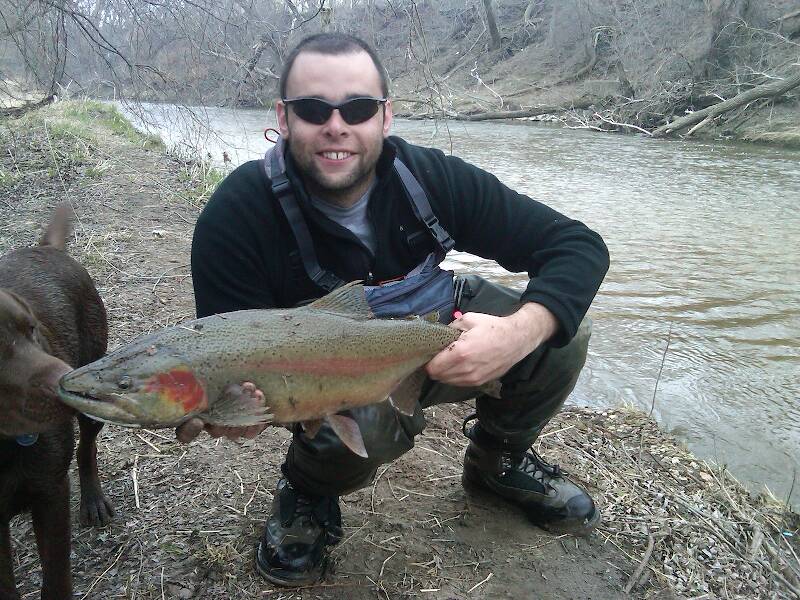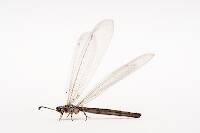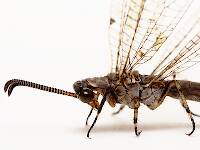
Salmonflies
Pteronarcys californica
The giant Salmonflies of the Western mountains are legendary for their proclivity to elicit consistent dry-fly action and ferocious strikes.
Featured on the forum

This one seems to lead to Couplet 35 of the Key to Genera of Perlodidae Nymphs and the genus Isoperla, but I'm skeptical that's correct based on the general look. I need to get it under the microscope to review several choices in the key, and it'll probably end up a different Perlodidae.

Troutnut is a project started in 2003 by salmonid ecologist Jason "Troutnut" Neuswanger to help anglers and
fly tyers unabashedly embrace the entomological side of the sport. Learn more about Troutnut or
support the project for an enhanced experience here.
Ffly on Mar 20, 2016March 20th, 2016, 12:23 am EDT
Hello everyone!
I'm about to start tying the dry flies I need this season for mostly trout, grayling and arctic char.
I want to keep my flybox really refined with one superb pattern for caddis dries and one for mayflies, midges and so on.
For the dry caddis it was an easy choice based on everything I've seen on the internet: Elk Hair caddis.
For the mayfly it seems like the Parachute Adams is widely regarded as one of the best patterns.
But then we have the F-fly... With the really nice perk of being so easy and fast to tie. I love that.
So for mayflies I was thinking if I really need the parachute adams when I got the f-fly tied up in various sizes? Does the parachute adams perform in a different way that the f-fly can't match?
Thanks!
I'm about to start tying the dry flies I need this season for mostly trout, grayling and arctic char.
I want to keep my flybox really refined with one superb pattern for caddis dries and one for mayflies, midges and so on.
For the dry caddis it was an easy choice based on everything I've seen on the internet: Elk Hair caddis.
For the mayfly it seems like the Parachute Adams is widely regarded as one of the best patterns.
But then we have the F-fly... With the really nice perk of being so easy and fast to tie. I love that.
So for mayflies I was thinking if I really need the parachute adams when I got the f-fly tied up in various sizes? Does the parachute adams perform in a different way that the f-fly can't match?
Thanks!
Wbranch on Mar 20, 2016March 20th, 2016, 6:48 am EDT
What in the world is an "f-fly"?
Edit: I googled "f-fly" and it to the gentleman that would like to use it as mayfly imitation in my opinion it is a caddis fly as there is no tail, and only two CDC feather tips tied in down wing style.
If you want to use this very simplistic fly to imitate a mayfly you should at least tie in a few tail fibers and lift the wing to at least a 45 degree angle to more closely replicate the wing of a mayfly.
http://www.flyfishsd.com/tying-the-f-fly/
Edit: I googled "f-fly" and it to the gentleman that would like to use it as mayfly imitation in my opinion it is a caddis fly as there is no tail, and only two CDC feather tips tied in down wing style.
If you want to use this very simplistic fly to imitate a mayfly you should at least tie in a few tail fibers and lift the wing to at least a 45 degree angle to more closely replicate the wing of a mayfly.
http://www.flyfishsd.com/tying-the-f-fly/
Catskill fly fisher for fifty-five years.
Ffly on Mar 20, 2016March 20th, 2016, 7:42 am EDT
The f-fly is a very famous fly here in Sweden and in pretty much of all of Europe I think. I don't know if the pattern is not that common in the US since you've never heard of it.
I've fished the f-fly dead drifting in slow water during baetis hatches, where the grayling refused caddis dries and even beadheaded nymphs. To me that experience was a sign that it was absolutely taken for a mayfly. Every rise was also calm, not splashy caddis takes.
Yeah, I thought about adding tail fibers on some of the f-flys so I'll definitely do that.
I was just curious to see if anyone had experienced the parachute adams being superior to the f-fly in any circumstances.
Cheers
I've fished the f-fly dead drifting in slow water during baetis hatches, where the grayling refused caddis dries and even beadheaded nymphs. To me that experience was a sign that it was absolutely taken for a mayfly. Every rise was also calm, not splashy caddis takes.
Yeah, I thought about adding tail fibers on some of the f-flys so I'll definitely do that.
I was just curious to see if anyone had experienced the parachute adams being superior to the f-fly in any circumstances.
Cheers
Wbranch on Mar 20, 2016March 20th, 2016, 8:22 am EDT
Until you made your post I had never heard of the f-fly. I am predominantly a dry fly fisherman so I would suggest to you that the f-fly is not well known in the USA or if it is known by some it is not advertised very much as I look at many fly fishing and fly tying magazines.
Catskill fly fisher for fifty-five years.
Roguerat on Mar 20, 2016March 20th, 2016, 2:01 pm EDT
Welcome, Ffly!
Interesting fly, stone-simple and minutes to wrap one. I had to Google it and found lots of European sites listing the F fly, only one in N America- a Pacific NW site noted this pattern.
As for the P Adams out-fishing it, I'd guess that's subjective- right water, right presentation, just the right fish on the right day and things click...
Anyway, just out of curiosity I'm going to tie up some F flies and see what the trout say.
Roguerat
'Less is more...'
Ludwig Mies Vande Rohe
Interesting fly, stone-simple and minutes to wrap one. I had to Google it and found lots of European sites listing the F fly, only one in N America- a Pacific NW site noted this pattern.
As for the P Adams out-fishing it, I'd guess that's subjective- right water, right presentation, just the right fish on the right day and things click...
Anyway, just out of curiosity I'm going to tie up some F flies and see what the trout say.
Roguerat
'Less is more...'
Ludwig Mies Vande Rohe
Troutnut on Mar 20, 2016March 20th, 2016, 7:41 pm EDT
The F fly is popular in Slovenia, too. A friend there loaned me one to catch some nice rising fish when none of my go-to U.S. flies were working. It was very effective on finicky fish.
I had a very hard time keeping it afloat after the first fish slimed it, but I have that problem with all CDC flies. If you like fishing CDC, the F fly is a great one.
I had a very hard time keeping it afloat after the first fish slimed it, but I have that problem with all CDC flies. If you like fishing CDC, the F fly is a great one.
Jason Neuswanger, Ph.D.
Troutnut and salmonid ecologist
Troutnut and salmonid ecologist
TNEAL on Mar 21, 2016March 21st, 2016, 4:46 am EDT
I had never heard of this one either, so I did a bit of poking around.This fly might float for a a bit on the right water conditions. As a commercial tyer, I would like to have an exclusive on this fly. I'm pretty sure it could be done in under a minute, making a ten dozen day a very part time endeavor.
Wbranch on Mar 21, 2016March 21st, 2016, 6:34 am EDT
Jason wrote;
I've seen you make a similar comment before relative to having issues with CDC floating. I think it has everything to do with the quality of the CDC you are using. I use CDC for most of my dry fly wings and for most of my caddis dry flies and they float very well with just one or two false casts.
If it gets slimy after catching a fish I wash it off in the river, then blot it dry, dip it in some desiccant like Frog's Fanny, shake or blow off the excess desiccant and I'm ready to fish again. If you PM me your mailing address I will send you some of my premium CDC so you can try it before buying a bag of your own.
I recently posted where I buy it. There is a fly shop in Last Chance, ID called "Trouthunters". Rene Harrop sells some of his flies out of that fly shop. They sell both natural and dyed CDC in small bags or 1/4 ounce bags for $17.50. A large bag can last me almost a year.
but I have that problem with all CDC flies.
I've seen you make a similar comment before relative to having issues with CDC floating. I think it has everything to do with the quality of the CDC you are using. I use CDC for most of my dry fly wings and for most of my caddis dry flies and they float very well with just one or two false casts.
If it gets slimy after catching a fish I wash it off in the river, then blot it dry, dip it in some desiccant like Frog's Fanny, shake or blow off the excess desiccant and I'm ready to fish again. If you PM me your mailing address I will send you some of my premium CDC so you can try it before buying a bag of your own.
I recently posted where I buy it. There is a fly shop in Last Chance, ID called "Trouthunters". Rene Harrop sells some of his flies out of that fly shop. They sell both natural and dyed CDC in small bags or 1/4 ounce bags for $17.50. A large bag can last me almost a year.
Catskill fly fisher for fifty-five years.
RleeP on Mar 21, 2016March 21st, 2016, 8:33 am EDT
Although I'd never heard of the F-fly until I read this thread, I'd probably be inclined to choose the Parachute Adams. I don't know that the Adams is the better of the two flies. As others have said, that probably depends more on the type of water being fished and what insects happen to be about, etc. I just don't like CDC, period It isn't really a question of supposed CDC quality differences between sources. I'd likely feel the same if the duck himself plucked it off his arse, bagged it and gave it to me. My experience with CDC has been that it requires more fiddle-farting around with when I could be fishing and that I haven't found an application where CDC is used that I can't adequately cover with snowshoe or a variety of different synthetics, all of which seem to require less fiddle-farting around with than CDC.
But that's just me. YMMV...
Now back down in the basement and make more pike flies on 4/0 hooks!
But that's just me. YMMV...
Now back down in the basement and make more pike flies on 4/0 hooks!
TNEAL on Mar 21, 2016March 21st, 2016, 11:06 am EDT
I would guess it takes quite a bit of cdc to float a 4/0 hook....
Ffly on Mar 21, 2016March 21st, 2016, 11:56 am EDT
Thanks for the welcoming Roguerat!
I’m amazed that a pattern can be so well known in Europe and apparently not in the US in this age of information. I guess not everything has reached everyone just yet hehe.
I’ve caught trout and grayling on it that were selectively feeding on mayflies or stoneflies, and of course it is also taken as a caddis. Also a great midge pattern. And if you factor in the tying time and ease it is really a contestant for one of the best dry flies out there.
Interesting that you, Jason, brought up the problem with the fly getting slimed up, it is true, but this year I’m going to tie a version of it called the improved f-fly.
The improved f-fly:
https://www.youtube.com/watch?v=PLaPnujqkRM
I hope the tweaks in this version of it will make this superb fly even better.
I’m amazed that a pattern can be so well known in Europe and apparently not in the US in this age of information. I guess not everything has reached everyone just yet hehe.
I’ve caught trout and grayling on it that were selectively feeding on mayflies or stoneflies, and of course it is also taken as a caddis. Also a great midge pattern. And if you factor in the tying time and ease it is really a contestant for one of the best dry flies out there.
Interesting that you, Jason, brought up the problem with the fly getting slimed up, it is true, but this year I’m going to tie a version of it called the improved f-fly.
The improved f-fly:
https://www.youtube.com/watch?v=PLaPnujqkRM
I hope the tweaks in this version of it will make this superb fly even better.
Wbranch on Mar 21, 2016March 21st, 2016, 12:07 pm EDT
RleeP wrote;
The tips of hig quity CDC make gorgeous up right wings for any dry fly. I use natural dark dun for my Hendicksons, Red Quills, Cornuta, and light gray for my Sulfurs, white for Trico duns, barred tan (I use an indelible black marker to make horizontal barring across the feather) for March Browns.
The first fly is a #14, the 2nd a #18, and the 3rd a #22.
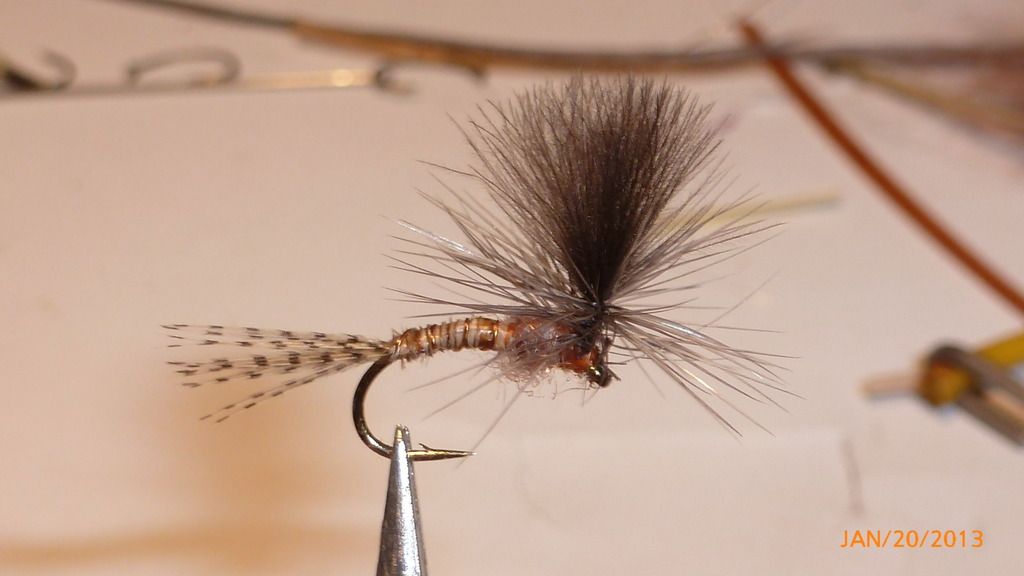
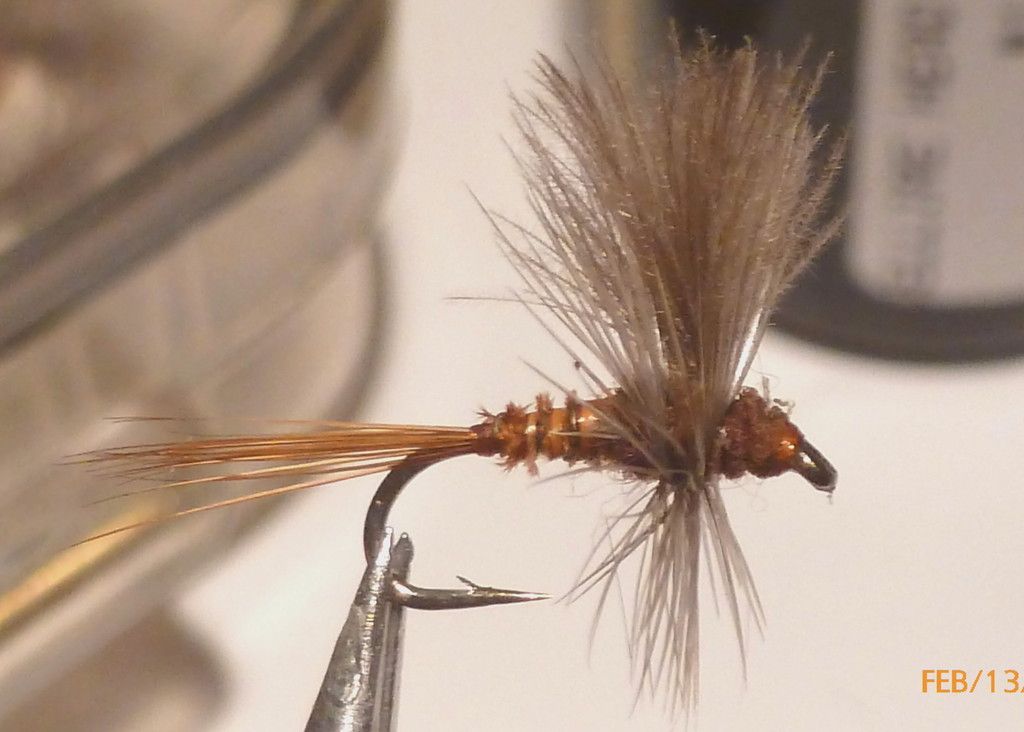

I haven't found an application where CDC is used that I can't adequately cover with snowshoe or a variety of different synthetics
The tips of hig quity CDC make gorgeous up right wings for any dry fly. I use natural dark dun for my Hendicksons, Red Quills, Cornuta, and light gray for my Sulfurs, white for Trico duns, barred tan (I use an indelible black marker to make horizontal barring across the feather) for March Browns.
The first fly is a #14, the 2nd a #18, and the 3rd a #22.



Catskill fly fisher for fifty-five years.
Planettrout on Mar 22, 2016March 22nd, 2016, 6:35 am EDT
The current Spring Issue of the Flyfishing & Tying Journal,here in the U.S., has two articles on tying both mayflies and caddis patterns with sparse CDC wings. The "Student" is the Mayfly pattern and "The Pupil" is the Caddis pattern. Both originated with Frank F. Johnson, a Billings , MT guide and tier and appear on pages 38-45.
I have been tying RS2 patterns with sparse CDC wings for years. This is an Epeorus Albertae (Pink Lady) pattern for the Madison River:
< />
...and this is a variant on Tracy Peterson's "Little Caddis Thing" which, in it's original design,is created using CDC for the abdomen and wing:
< />
Tracy, who quotes Rene Harrop, says that most tiers do not use enough CDC in the construction of CDC patterns and hence, their frustration with the seeming limit on the pattern's ability to float after being "slimed".There are a host of suggestions for drying CDC patterns, including that neat trick with the rubber band. I prefer Marc Petitjean CDC over CDC from The Trouthunter...
Hope you find a simple CDC Caddis pattern that brings lot of fish to hand :-)
PT/TB
I have been tying RS2 patterns with sparse CDC wings for years. This is an Epeorus Albertae (Pink Lady) pattern for the Madison River:
< />

...and this is a variant on Tracy Peterson's "Little Caddis Thing" which, in it's original design,is created using CDC for the abdomen and wing:
< />

Tracy, who quotes Rene Harrop, says that most tiers do not use enough CDC in the construction of CDC patterns and hence, their frustration with the seeming limit on the pattern's ability to float after being "slimed".There are a host of suggestions for drying CDC patterns, including that neat trick with the rubber band. I prefer Marc Petitjean CDC over CDC from The Trouthunter...
Hope you find a simple CDC Caddis pattern that brings lot of fish to hand :-)
PT/TB
Daughter to Father: "How many arms do you have, how many fly rods do you need?"
http://planettrout.wordpress.com/
http://planettrout.wordpress.com/
Entoman on Mar 22, 2016March 22nd, 2016, 9:34 am EDT
The best cdc by far comes from wild ducks. Of course, you can't buy it, you have to shoot it... ;)
I never use desiccant on this material as it tends to get caught in the fiberious feather and ruins it by degrading the natural oils over time. Best approach is to slap the fly on the water with multiple short false casts (away from the water you're fishing), followed by blotting and a few brisk lung blasts. This method is far superior at ridding fish slime than just swishing the fly. You are good to go for several fish. Eventually the fly will get too soaked for this to work. When that happens, change flies and let the used one dry on a patch. By the time you are fighting a losing battle with drying the second fly the first fly is ready to go again. Besides, you should retie your fly after several good fish anyway, so no time is lost.
I never use desiccant on this material as it tends to get caught in the fiberious feather and ruins it by degrading the natural oils over time. Best approach is to slap the fly on the water with multiple short false casts (away from the water you're fishing), followed by blotting and a few brisk lung blasts. This method is far superior at ridding fish slime than just swishing the fly. You are good to go for several fish. Eventually the fly will get too soaked for this to work. When that happens, change flies and let the used one dry on a patch. By the time you are fighting a losing battle with drying the second fly the first fly is ready to go again. Besides, you should retie your fly after several good fish anyway, so no time is lost.
"It's not that I find fishing so important, it's just that I find all other endeavors of Man equally unimportant... And not nearly as much fun!" Robert Traver, Anatomy of a Fisherman
Wbranch on Mar 22, 2016March 22nd, 2016, 9:44 pm EDT
I've never had the need to feel the Trouthunter CDC was not providing the floatation I desired to seek out another vendor. Prior to locating the Trouthunter CDC I bought CDC from many different vendors none of who provided a feather approaching the density of barbules that the Trouthunter provides.
I do believe in winging with CDC that more is better. I use three tips for my dun wings and three for my caddis wings. I discard the remainder of the feather. I don't know if it matters but for the dun wings I lay two of the feathers down on my table with the curve facing up and lay the third over the top of the other two with the curve facing down. Then I align the feathers so the three tips are even and tie them in.
I do believe in winging with CDC that more is better. I use three tips for my dun wings and three for my caddis wings. I discard the remainder of the feather. I don't know if it matters but for the dun wings I lay two of the feathers down on my table with the curve facing up and lay the third over the top of the other two with the curve facing down. Then I align the feathers so the three tips are even and tie them in.
Catskill fly fisher for fifty-five years.
Kschaefer3 on Mar 23, 2016March 23rd, 2016, 6:13 am EDT
The best cdc by far comes from wild ducks. Of course, you can't buy it, you have to shoot it... ;)
I never use desiccant on this material as it tends to get caught in the fiberious feather and ruins it by degrading the natural oils over time. Best approach is to slap the fly on the water with multiple short false casts (away from the water you're fishing), followed by blotting and a few brisk lung blasts. This method is far superior at ridding fish slime than just swishing the fly. You are good to go for several fish. Eventually the fly will get too soaked for this to work. When that happens, change flies and let the used one dry on a patch. By the time you are fighting a losing battle with drying the second fly the first fly is ready to go again. Besides, you should retie your fly after several good fish anyway, so no time is lost.
I duck hunted a lot in college, but didn't tie flies. It's quite a shame as I could have had bags and bags of cdc and othe goodies.
Gutcutter on Mar 24, 2016March 24th, 2016, 7:22 am EDT
Tim
In the caddis photo, I think I see a CDC feather base. I do that, too and it seems that there is a lot of fiber density (more buoyancy?) in that part of the feather.
Also, I agree with Kurt that the silica powder desiccants shouldn't be used, except as a last resort i.e. that fly is getting every fish to sip it and it's the last fly of it's type/size/color that you have in your box 'cause you lost all the rest of 'em...
In the caddis photo, I think I see a CDC feather base. I do that, too and it seems that there is a lot of fiber density (more buoyancy?) in that part of the feather.
Also, I agree with Kurt that the silica powder desiccants shouldn't be used, except as a last resort i.e. that fly is getting every fish to sip it and it's the last fly of it's type/size/color that you have in your box 'cause you lost all the rest of 'em...
All men who fish may in turn be divided into two parts: those who fish for trout and those who don't. Trout fishermen are a race apart: they are a dedicated crew- indolent, improvident, and quietly mad.
-Robert Traver, Trout Madness
-Robert Traver, Trout Madness
Wbranch on Mar 24, 2016March 24th, 2016, 5:42 pm EDT
The experts have spoken.
Catskill fly fisher for fifty-five years.
Troutnut on Mar 29, 2016March 29th, 2016, 6:37 pm EDT
Best approach is to slap the fly on the water with multiple short false casts (away from the water you're fishing),
I've never heard of that technique. I always try to crack the fly like a whip at the end of the tippet to dry it out. It seems kind of counter-intuitive to slap it on the water, but does it work a lot better?
Jason Neuswanger, Ph.D.
Troutnut and salmonid ecologist
Troutnut and salmonid ecologist
Taxon on Mar 30, 2016March 30th, 2016, 12:47 am EDT
Jason-
My experience has been similar to yours with regard to cdc getting slimed, so I have also avoided its use. :-)
My experience has been similar to yours with regard to cdc getting slimed, so I have also avoided its use. :-)
Quick Reply
Related Discussions
Topic
Replies
Last Reply
6
Nov 4, 2011
by Dinerobyn
by Dinerobyn



